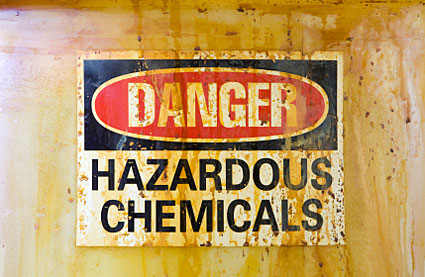 U.S. manufacturers and agribusiness are addicted to endocrine disruptors — dangerous chemicals that alter the natural function of the body’s hormones. They are frequently used in plastics, in pesticides, and in personal care products and act in the human body as a “false” version of estrogen. They appear to be linked to a variety of diseases, including sexual dysfunction, heart disease, metabolic disorders, and cancer. New York Times columnist Nick Kristof wrote a frightening summary of the health and evironmental risks of this class of chemicals about a year ago that’s still timely.
U.S. manufacturers and agribusiness are addicted to endocrine disruptors — dangerous chemicals that alter the natural function of the body’s hormones. They are frequently used in plastics, in pesticides, and in personal care products and act in the human body as a “false” version of estrogen. They appear to be linked to a variety of diseases, including sexual dysfunction, heart disease, metabolic disorders, and cancer. New York Times columnist Nick Kristof wrote a frightening summary of the health and evironmental risks of this class of chemicals about a year ago that’s still timely.
Although the controversial plastic ingredient bisphenol-A, used in canned foods and baby bottles, is certainly the poster child for endocrine disruptors’ ubiquity, it is merely one of many. The pesticide atrazine, banned in the European Union but still widely overused in the U.S., is also a potent endocrine disruptor, as is the chemical oxybenzone, one of the most common ingredients in U.S.-sold sunscreen, though it too is banned in the E.U.
These, of course, are only the high-profile examples. For each one, industry threatens the End of Civilization in the event that the FDA attempts to restrict one or another. Atrazine, for example, is currently under review by the EPA. Despite the fact that European farmers seem to have maintained yields wthout the chemical, American agribusiness still manages to say with a straight face that banning atrazine will cause U.S. corn yields to drop precipitiously. Meanwhile, we learn that atrazine, one of the most common waterway contaminants in the entire country, can disrupt the hormone function (and reproduction) of fish at levels well below legal pollution limits.
The resistance of the industry and our own elected representatives to acting on our behalf is scary enough. But far more terrifying is the research that continues to pour in showing the dangers of endocrine-disrupting chemicals. Now a group of longtime environmental researchers from Tufts University have done their own review of past research into BPA and other endocrine disruptors (abstract available here).
Their conclusions:
1) BPA and chemicals like it do indeed pose an increased cancer risk — that’s in addition to the reproductive and metabolic risks they represent. And these chemicals represent a real and potent threat to the health of pregnant women and their fetuses.
2) The complexity of these chemicals and their interactions is so great that we don’t even have the tools to determine what they’re really doing to us. We truly are lab rats in a worldwide experiment.
The researchers conclude that there is more than enough evidence to support “rapid action to diminish these harmful environmental exposures.”
In other words: FDA and EPA, get off your arses and ban this stuff now.




